Flume
Flume
Flume是Cloudera提供的一个高可用的,高可靠的,分布式的海量日志采集、聚合和传输的系统,Flume支持在日志系统中定制各类数据发送方,用于收集数据;同时,Flume提供对数据进行简单处理,并写到各种数据接受方(可定制)的能力。
- 他有一个简单、灵活的基于流的数据结构
- 具有负载均衡机制和故障转移机制
- 一个简单可扩展的数据模型
- Source 数据源,从外界采集各种类型的数据,传递给Channel,Source类型有:文件、目录、端口、Kafaka等
- * Exec Source:实现文件监控
- NetCat TCP/UDP Source:采集指定端口(tcp、udp)的数据
- Spooling Directory Source:采集文件夹中新增文件
- * Kafka Source:从Kafaka读取数据
- Channel 临时存储数据的管道
Channel 中的数据直到进入目的地才会被删除, 当 Sink 写入目的地失败后, 可以自动重写, 不会造成数据丢失, 这块是有一个事务保证的。
- Memory Channel:使用内存作为数据存储
优点:速度快,不涉及磁盘IO。
缺点:可能丢数据;内存有限,可能存在内存不够用。 - File Channel:使用文件来作为数据的存储
优点:数据不会丢失
缺点:效率相对内存来说会有点慢, 但是这个慢并没有我们想象中的那么慢, 所以这个也是比较常用的一种 channel - Spillable Memory Channel : 使用内存和文件作为数据存储, 即先把数据存到内存中, 如果内存中 数据达到阈值再 fl ush 到文件中
优点: 解决了内存不够用的问题
缺点: 还是存在数据丢失的风险
- Memory Channel:使用内存作为数据存储
- Sink 目的地
Sink 的表现形式有很多: 打印到控制台、 HDFS 、 Kafka 等。
- Logger Sink : 将数据作为日志处理, 可以选择打印到控制台或者写到文件中,这个主要在测试的时候使用
- HDFS Sink : 将数据传输到 HDFS 中,这个是比较常见的,主要针对离线计算的场景
- Kafka Sink : 将数据发送到 kafka 消息队列中,这个也是比较常见的,主要针对实时计算场景,数据不落盘,实时传输,最后使用实时计算框架直接处理
- Source 数据源,从外界采集各种类型的数据,传递给Channel,Source类型有:文件、目录、端口、Kafaka等
工作模型:
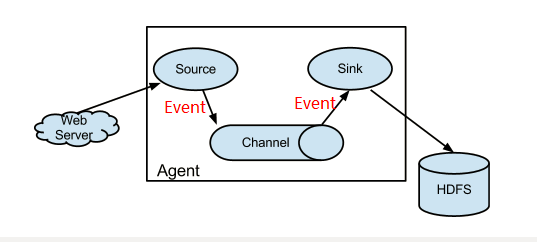
高级场景:
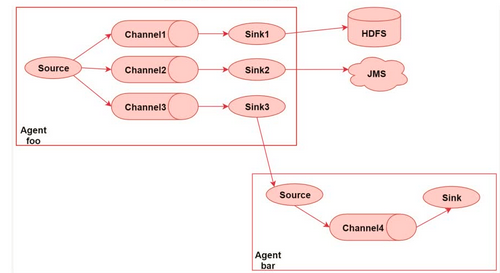
图中有两个agent,Agent foo能将读取到的数据传输到不同的目的地,sink1将数据写入HDFS,sink2将数据写入java消息队列服务,sink3将数据写入另一个Agent
汇聚功能:
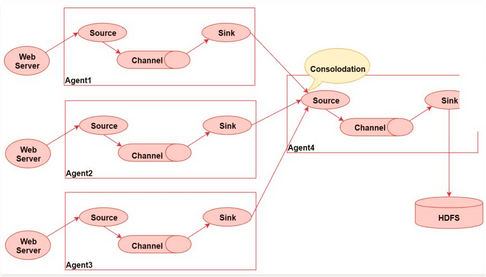
flume 配置文件:( https://flume.apache.org/releases/content/1.9.0/FlumeUserGuide.html#configuration )放在flume的conf目录下,以 .conf 或 .conf.propertites 结尾
# example.conf: A single-node Flume configuration
# a1 为agent的名称
# Name the components on this agent
a1.sources = r1
a1.sinks = k1
a1.channels = c1
# Describe/configure the source
a1.sources.r1.type = netcat
a1.sources.r1.bind = localhost
a1.sources.r1.port = 44444
# Describe the sink
a1.sinks.k1.type = logger
# Use a channel which buffers events in memory
a1.channels.c1.type = memory
a1.channels.c1.capacity = 1000
a1.channels.c1.transactionCapacity = 100
# Bind the source and sink to the channel
a1.sources.r1.channels = c1
a1.sinks.k1.channel = c1启动
$ bin/flume-ng agent
--conf conf[配置文件目录]
--conf-file example.conf[刚刚创建的配置文件]
--name a1[agent名称,必须与配置文件中agent的名称一致]
-Dflume.root.logger=INFO,console
# 简写形式
$ bin/flume-ng agent -n $agent_name -c conf -f conf/flume-conf.properties.template采集文件内容上传至HDFS
# conf/file-to-hdfs.conf
# Name the components on this agent
a1.sources = r1
a1.sinks = k1
a1.channels = c1
# Describe/configure the source
a1.sources.r1.type = spooldir
a1.sources.r1.spoolDir = /var/log
# channel
a1.channels.c1.type = file
a1.channels.c1.checkpointDir = /mnt/flume/checkpoint
a1.channels.c1.dataDirs = /mnt/flume/data
# Describe the sink
a1.sinks.k1.type = hdfs
a1.sinks.k1.hdfs.path = hdfs:///flume/events/%y-%m-%d/%H%M/%S
a1.sinks.k1.hdfs.filePrefix = events-
a1.sinks.k1.hdfs.fileType = DataStream
a1.sinks.k1.hdfs.writeFormat = Text # 注意:当使用 hdfs sink 时需要用到hadoop的jar包,解决方法是在这台机器解压一个hadoop并配置HADOOP_HOME
a1.sinks.k1.hdfs.rollInterval = 30 # 30秒切分一下文件
a1.sinks.k1.hdfs.rollSize = 1024 # 文件达到1024字节切分文件
a1.sinks.k1.hdfs.rollCount = 10 # 每10次event切分一次文件
# Bind the source and sink to the channel
a1.sources.r1.channels = c1
a1.sinks.k1.channel = c1采集网站日志上传至HDFS
A和B两台机器的实时产生的日志数据汇总到机器C中,通过机器C将数据统一上传到HDFS的指定目录中。HDFS中的目录是按天生成的,每天一个目录。
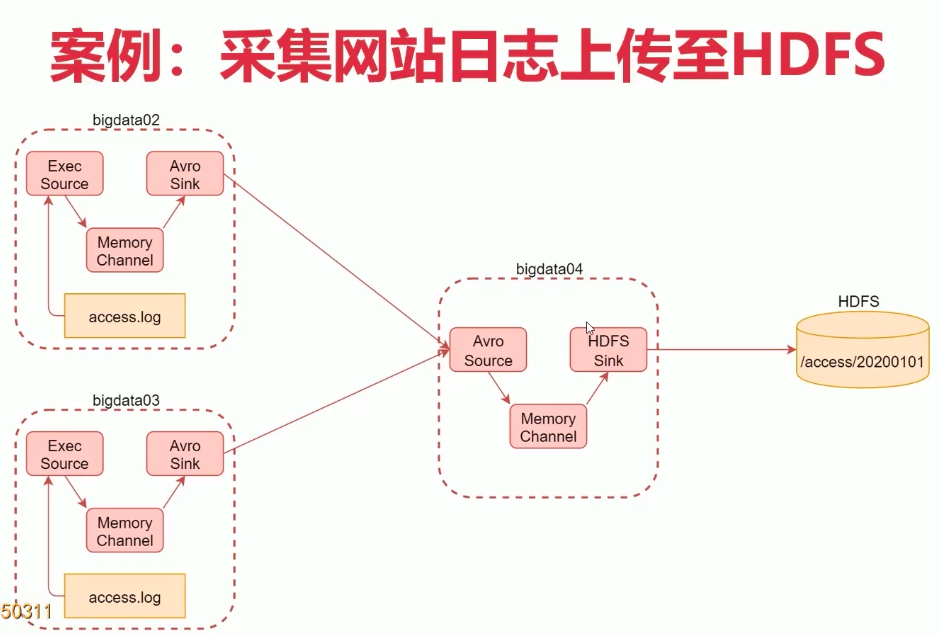
bigdata02和bigdata03需要采集日志文件,所以使用File Source;日志文件可以接受丢失,所以使用 Memory Channel;为了加快传输,使用Avro Sink进行网络传输,Avro是一种序列化系统,使用它传输数据效率更高。
bigdata 2和3 的配置文件
# 配置 agent
a1.sources = r1
a1.sinks = k1
a1.channels = c1
# 配置 source
a1.sources.r1.type = exec
a1.sources.r1.command = tail -F /var/log/web.log
# 配置 channel
a1.channels.c1.type = memory
a1.channels.c1.capacity = 1000
a1.channels.c1.transactionCapacity = 100
# 配置 sink
a1.sinks.k1.type = avro
a1.sinks.k1.hostname = 192.168.56.155
a1.sinks.k1.port = 45454
# 绑定
a1.sources.r1.channels = c1
a1.sinks.k1.channel = c1bigdata04 配置
# 配置 agent
a1.sources = r1
a1.sinks = k1
a1.channels = c1
# 配置 source
a1.sources.r1.type = avro
a1.sources.r1.bind = 0.0.0.0
a1.sources.r1.port = 45454
# 配置 channel
a1.channels.c1.type = memory
# 配置 sink
a1.sinks.k1.type = hdfs
a1.sinks.k1.hdfs.path = hdfs:///access/%Y%m%d
a1.sinks.k1.hdfs.useLocalTimeStamp = true
a1.sinks.k1.hdfs.fileType = DataStream
a1.sinks.k1.hdfs.writeFormat = Text
a1.sinks.k1.hdfs.rollInterval = 3600
# 绑定
a1.sources.r1.channels = c1
a1.sinks.k1.channel = c1高级组件
Event
Event 是 Flume 传输数据的基本单位,也是事务的基本单位,在文本文件中, 通常一行记录就是一个 Event。Event 中包含 header 和 body
- body 是采集到的那一行记录的原始内容
- header 类型为 Map<String, String> , 里面可以存储一些属性信息, 方便后面使用
我们可以在 Source 中给每一条数据的 header 中增加 key-value , 在 Channel 和 Sink 中使用 header 中的值了。
- Source Interceptors : Source 可以指定一个或者多个拦截器按先后顺序依次对采集到的数据进行处 理。
- Channel Selectors : Source 发往多个 Channel 的策略设置, 如果 source 后面接了多个 channel , 到 底是给所有的 channel 都发, 还是根据规则发送到不同 channel , 这些是由 Channel Selectors 来控制 的
- Sink Processors : Sink 发送数据的策略设置, 一个 channel 后面可以接多个 sink , channel 中的数据 是被哪个 sink 获取, 这个是由 Sink Processors 控制的
SourceInterceptors
Source 可以指定一个或者多个拦截器按先后顺序依次对采集到的数据进行处 理
- Timestamp Interceptor : 向 event 中的 header 里面添加 timestamp 时间戳信息
- Host Interceptor : 向 event 中的 header 里面添加 host 属性, host 的值为当前机器的主机名或者 ip
- Search and Replace Interceptor : 根据指定的规则查询 Event 中 body 里面的数据, 然后进行替换, 这个拦截器会修改 event 中 body 的值, 也就是会修改原始采集到的数据内容
- Static Interceptor : 向 event 中的 header 里面添加固定的 key 和 value
- Regex Extractor Interceptor : 根据指定的规则从 Event 中的 body 里面抽取数据, 生成 key 和 value , 再把 key 和 value 添加到 header 中
例:根据source的值确定写入的目录名称
ExecSource -> Search and Replace Interceptor -> Regex Extraxtor Interceptor -> File Channel -> HDFS Sink
# agent 的名称是 a1
# 指定 source 组件、 channel 组件和 Sink 组件的名称
a1.sources = r1
a1.channels = c1
a1.sinks = k1
# 配置 source 组件
a1.sources.r1.type = exec
a1.sources.r1.command = tail -F /data/log/moreType.log
# 配置拦截器 [ 多个拦截器按照顺序依次执行 ]
a1.sources.r1.interceptors = i1 i2 i3 i4
a1.sources.r1.interceptors.i1.type = search_replace
a1.sources.r1.interceptors.i1.searchPattern = "type":"video_info" # 规则可以使用正则
a1.sources.r1.interceptors.i1.replaceString = "type":"videoInfo"
a1.sources.r1.interceptors.i2.type = search_replace
a1.sources.r1.interceptors.i2.searchPattern = "type":"user_info"
a1.sources.r1.interceptors.i2.replaceString = "type":"userInfo"
a1.sources.r1.interceptors.i3.type = search_replace
a1.sources.r1.interceptors.i3.searchPattern = "type":"gift_record"
a1.sources.r1.interceptors.i3.replaceString = "type":"giftRecord"
a1.sources.r1.interceptors.i4.type = regex_extractor
a1.sources.r1.interceptors.i4.regex = "type":"(\\w+)"
a1.sources.r1.interceptors.i4.serializers = s1 # 用于生成 logType=>\\w+ 值为正则中的一组
a1.sources.r1.interceptors.i4.serializers.s1.name = logType
# 配置 channel 组件
a1.channels.c1.type = file
a1.channels.c1.checkpointDir = /data/soft/apache-flume-1.9.0-bin/data/moreTyp
a1.channels.c1.dataDirs = /data/soft/apache-flume-1.9.0-bin/data/moreType/dat
# 配置 sink 组件
a1.sinks.k1.type = hdfs
a1.sinks.k1.hdfs.path = hdfs://192.168.182.100:9000/moreType/%Y%m%d/%{logType
a1.sinks.k1.hdfs.fileType = DataStream
a1.sinks.k1.hdfs.writeFormat = Text
a1.sinks.k1.hdfs.rollInterval = 3600
a1.sinks.k1.hdfs.rollSize = 134217728
a1.sinks.k1.hdfs.rollCount = 0
a1.sinks.k1.hdfs.useLocalTimeStamp = true
# 增加文件前缀和后缀
a1.sinks.k1.hdfs.filePrefix = data
a1.sinks.k1.hdfs.fileSuffix = .log
# 把组件连接起来
a1.sources.r1.channels = c1
a1.sinks.k1.channel = c1
Channel Selectors
Source 发往多个 Channel 的策略设置, 如果 source 后面接了多个 channel , 到底是给所有的 channel 都发, 还是根据规则发送到不同 channel , 这些是由 Channel Selectors 来控制的
- Replicating Channel Selector:默认使用,它会将 Source 采集过来的 Event 发往所有 Channel
a1.sources = r1 a1.channels = c1 c2 c3 a1.sources.r1.selector.type = replicating a1.sources.r1.channels = c1 c2 c3 a1.sources.r1.selector.optional = c3 # c3 为可选,所以当写入数据失败时会被忽略 # 写入 c1 c2 失败时会导致事务性的失败,会重写 - Multiplexing Channel Selector:根据 Event 中 header 里面的值将 Event 发往不同的 Channel
a1.sources = r1 a1.channels = c1 c2 c3 c4 a1.sources.r1.selector.type = multiplexing a1.sources.r1.selector.header = state a1.sources.r1.selector.mapping.CZ = c1 a1.sources.r1.selector.mapping.US = c2 c3 a1.sources.r1.selector.default = c4 # 如果 state 属性的值是 CZ , 则发送给 c1 # 如果 state 属性的值是 US , 则发送给 c2 c3 # 如果 state 属性的值是其它值, 则发送给 c4
将收集的文件传输到Logger和HDFS上
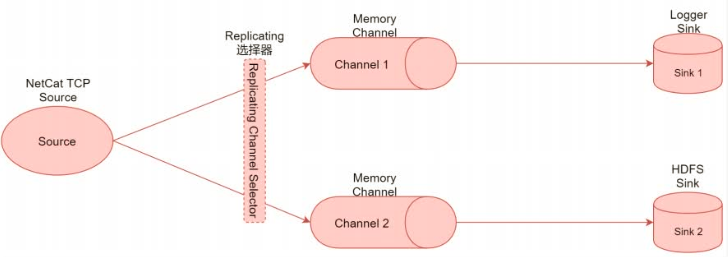
# agent 的名称是 a1
# 指定 source 组件、 channel 组件和 Sink 组件的名称
a1.sources = r1
a1.channels = c1 c2
a1.sinks = k1 k2
# 配置 source 组件
a1.sources.r1.type = netcat
a1.sources.r1.bind = 0.0.0.0
a1.sources.r1.port = 44444
# 配置 channle 选择器 [ 默认就是 replicating , 所以可以省略 ]
a1.sources.r1.selector.type = replicating
# 配置 channel 组件
a1.channels.c1.type = memory
a1.channels.c1.capacity = 1000
a1.channels.c1.transactionCapacity = 100
a1.channels.c2.type = memory
a1.channels.c2.capacity = 1000
a1.channels.c2.transactionCapacity = 100
# 配置 sink 组件
a1.sinks.k1.type = logger
a1.sinks.k2.type = hdfs
a1.sinks.k2.hdfs.path = hdfs://192.168.182.100:9000/replicating
a1.sinks.k2.hdfs.fileType = DataStream
a1.sinks.k2.hdfs.writeFormat = Text
a1.sinks.k2.hdfs.rollInterval = 3600
a1.sinks.k2.hdfs.rollSize = 134217728
a1.sinks.k2.hdfs.rollCount = 0
a1.sinks.k2.hdfs.useLocalTimeStamp = true
a1.sinks.k2.hdfs.filePrefix = data
a1.sinks.k2.hdfs.fileSuffix = .log
# 把组件连接起来 a1.sources.r1.channels = c1 c2
a1.sinks.k1.channel = c1
a1.sinks.k2.channel = c2
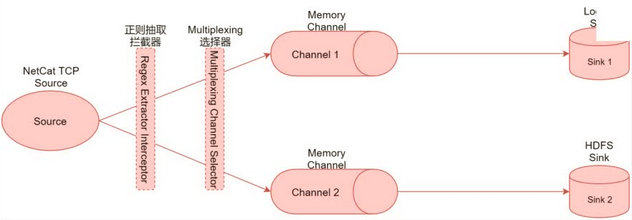
# agent 的名称是 a1
# 指定 source 组件、 channel 组件和 Sink 组件的名称
a1.sources = r1
a1.channels = c1 c2
a1.sinks = k1 k2
# 配置 source 组件
a1.sources.r1.type = netcat
a1.sources.r1.bind = 0.0.0.0
a1.sources.r1.port = 44444
# 配置 source 拦截器
a1.sources.r1.interceptors = i1
a1.sources.r1.interceptors.i1.type = regex_extractor
a1.sources.r1.interceptors.i1.regex = "city":"(\\w+)"
a1.sources.r1.interceptors.i1.serializers = s1
a1.sources.r1.interceptors.i1.serializers.s1.name = city
# 配置 channle 选择器
a1.sources.r1.selector.type = multiplexing
a1.sources.r1.selector.header = city
a1.sources.r1.selector.mapping.bj = c1
a1.sources.r1.selector.default = c2
# 配置 channel 组件
a1.channels.c1.type = memory
a1.channels.c1.capacity = 1000
a1.channels.c1.transactionCapacity = 100
a1.channels.c2.type = memory
a1.channels.c2.capacity = 1000
a1.channels.c2.transactionCapacity = 100
# 配置 sink 组件
a1.sinks.k1.type = logger
a1.sinks.k2.type = hdfs
a1.sinks.k2.hdfs.path = hdfs://192.168.182.100:9000/multiplexing
a1.sinks.k2.hdfs.fileType = DataStream
a1.sinks.k2.hdfs.writeFormat = Text
a1.sinks.k2.hdfs.rollInterval = 3600
a1.sinks.k2.hdfs.rollSize = 134217728
a1.sinks.k2.hdfs.useLocalTimeStamp = true
a1.sinks.k2.hdfs.filePrefix = data
a1.sinks.k2.hdfs.fileSuffix = .log
# 把组件连接起来
a1.sources.r1.channels = c1 c2
a1.sinks.k1.channel = c1
a1.sinks.k2.channel = c2
Sink Processors
Sink 发送数据的策略设置, 一个 channel 后面可以接多个 sink , channel 中的数据 是被哪个 sink 获取, 这个是由 Sink Processors 控制的
- Default Sink Processor:默认,无需配置
- Load balancing Sink Processor:负载均衡处理器, 一个 channle 后面可以接多个 sink , 这多个 sink 属于 一个 sink group , 根据指定的算法进行轮询或者随机发送, 减轻单个 sink 的压力
a1.sinkgroups = g1 a1.sinkgroups.g1.sinks = k1 k2 a1.sinkgroups.g1.processor.type = load_balance a1.sinkgroups.g1.processor.backoff = true a1.sinkgroups.g1.processor.selector = random # 轮询:round_robin - Failover Sink Processor:故障转移处理器, 一个 channle 后面可以接多个 sink , 这多个 sink 属于一个 sink group , 按照 si nk 的优先级, 默认先让优先级高的 sink 来处理数据, 如果这个 si nk 出现了故障, 则用 优先级低一点的 sink 处理数据, 可以保证数据不丢失。
a1.sinkgroups = g1 a1.sinkgroups.g1.sinks = k1 k2 a1.sinkgroups.g1.processor.type = failover a1.sinkgroups.g1.processor.priority.k1 = 5 a1.sinkgroups.g1.processor.priority.k2 = 10 a1.sinkgroups.g1.processor.maxpenalty = 10000
Load balancing Sink Processor

bigdata04 配置文件:
bigdata04
# agent 的名称是 a1
# 指定 source 组件、 channel 组件和 Sink 组件的名称
a1.sources = r1
a1.channels = c1
a1.sinks = k1 k2
# 配置 source 组件
a1.sources.r1.type = netcat
a1.sources.r1.bind = 0.0.0.0
a1.sources.r1.port = 44444
# 配置 channel 组件
a1.channels.c1.type = memory
a1.channels.c1.capacity = 1000
a1.channels.c1.transactionCapacity = 100
# 配置 sink 组件 , [ 为了方便演示效果, 把 batch-size 设置为 1]
a1.sinks.k1.type=avro
a1.sinks.k1.hostname=192.168.182.101
a1.sinks.k1.port=41414
a1.sinks.k1.batch-size = 1
a1.sinks.k2.type=avro
a1.sinks.k2.hostname=192.168.182.102
a1.sinks.k2.port=41414
a1.sinks.k2.batch-size = 1
# 配置 sink 策略
a1.sinkgroups = g1
a1.sinkgroups.g1.sinks = k1 k2
a1.sinkgroups.g1.processor.type = load_balance
a1.sinkgroups.g1.processor.backoff = true
a1.sinkgroups.g1.processor.selector = round_robin
# 把组件连接起来
a1.sources.r1.channels = c1
a1.sinks.k1.channel = c1
a1.sinks.k2.channel = c1bigdata02 bigdata03 配置文件
bigdata02 bigdata03
# 指定 source 组件、 channel 组件和 Sink 组件的名称
a1.sources = r1
a1.channels = c1
a1.sinks = k1
# 配置 source 组件
a1.sources.r1.type = avro
a1.sources.r1.bind = 0.0.0.0
a1.sources.r1.port = 41414
# 配置 channel 组件
a1.channels.c1.type = memory
a1.channels.c1.capacity = 1000
a1.channels.c1.transactionCapacity = 100
# 配置 sink 组件
a1.sinks.k1.type = hdfs
a1.sinks.k1.hdfs.path = hdfs://192.168.182.100:9000/load_balance
a1.sinks.k1.hdfs.fileType = DataStream
a1.sinks.k1.hdfs.writeFormat = Text
a1.sinks.k1.hdfs.rollInterval = 3600
a1.sinks.k1.hdfs.rollSize = 134217728
a1.sinks.k1.hdfs.rollCount = 0
a1.sinks.k1.hdfs.useLocalTimeStamp = true
a1.sinks.k1.hdfs.fileSuffix = .log
# 把组件连接起来
a1.sources.r1.channels = c1
a1.sinks.k1.channel = c1Failover Sink Processor
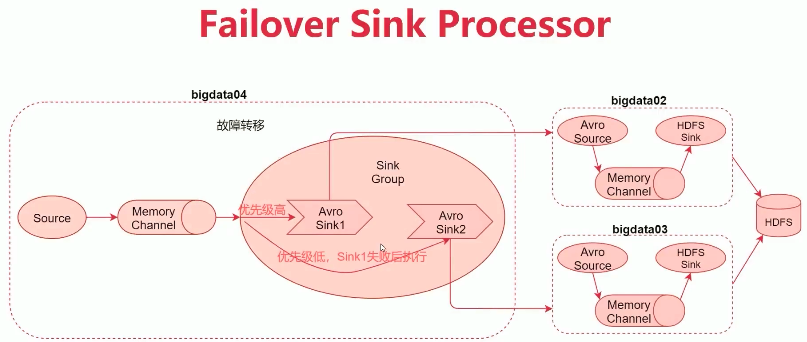
bigdata04 配置文件
bigdata04
# agent 的名称是a1
# 指定 source 组件、 channel 组件和 Sink 组件的名称
a1.sources = r1
a1.channels = c1
a1.sinks = k1 k2
# 配置 source 组件
a1.sources.r1.type = netcat
a1.sources.r1.bind = 0.0.0.0
a1.sources.r1.port = 44444
# 配置 channel 组件
a1.channels.c1.type = memory
a1.channels.c1.capacity = 1000
a1.channels.c1.transactionCapacity = 100
# 配置 sink 组件 , [ 为了方便演示效果, 把 batch-size 设置为 1]
a1.sinks.k1.type = avro
a1.sinks.k1.hostname = 192.168.182.101
a1.sinks.k1.port = 41414
a1.sinks.k1.batch-size = 1
a1.sinks.k2.type = avro
a1.sinks.k2.hostname = 192.168.182.102
a1.sinks.k2.port = 41414
a1.sinks.k2.batch-size = 1
# 配置 sink 策略
a1.sinkgroups = g1
a1.sinkgroups.g1.sinks = k1 k2
a1.sinkgroups.g1.processor.type = failover
a1.sinkgroups.g1.processor.priority.k1 = 5
a1.sinkgroups.g1.processor.priority.k2 = 10
# 把组件连接起来
a1.sources.r1.channels = c1
a1.sinks.k1.channel = c1
a1.sinks.k2.channel = c1bigdata02 bigdata03 配置文件
bigdata02 bigdata03
# agent 的名称是a1
# 指定 source 组件、 channel 组件和 Sink 组件的名称
a1.sources = r1
a1.channels = c1
a1.sinks = k1
# 配置 source 组件
a1.sources.r1.type = avro
a1.sources.r1.bind = 0.0.0.0
a1.sources.r1.port = 41414
# 配置 channel 组件
a1.channels.c1.type = memory
a1.channels.c1.capacity = 1000
a1.channels.c1.transactionCapacity = 100
# 配置 sink 组件 [ 为了区分两个 sink 组件生成的文件, 修改 filePrefix 的值 ]
a1.sinks.k1.type = hdfs
a1.sinks.k1.hdfs.path = hdfs://192.168.182.100:9000/failover
a1.sinks.k1.hdfs.fileType = DataStream
a1.sinks.k1.hdfs.writeFormat = Text
a1.sinks.k1.hdfs.rollInterval = 3600
a1.sinks.k1.hdfs.rollSize = 134217728
a1.sinks.k1.hdfs.rollCount = 0
a1.sinks.k1.hdfs.useLocalTimeStamp = true
a1.sinks.k1.hdfs.filePrefix = data101
a1.sinks.k1.hdfs.fileSuffix = .log
# 把组件连接起来
a1.sources.r1.channels = c1
a1.sinks.k1.channel = c1优化
- 调整 Flume 进程的内存大小, 建议设置 1 G~2G , 太小的话会导致频繁 GC
查看jvm占用内存命令:jps和jstat -gcutil PID 1000
调整方法:调整 flume-env.s h 脚本中的 JAVA_OPTS 参数 把 export JAVA_OPTS 参数前面的 # 号去掉才会生效。export JAVA_OPTS="-Xms1024m -Xmx1024m -Dcom.sun.management.jmxremote" - 在一台服务器启动多个 agent 的时候, 建议修改配置区分日志文件。否则多个agent将日志输出到同一个目录,会导致冲突。
修改log4j.properties下的flume.log.dir和flume.log.file
进程监控
Flume是一个单进程程序,存在单点故障,所以需要一个监控机制,当Flume宕机后需要重启。
解决方法:通过shell脚本监控Flume进程及重启
- 创建一个配置文件,记录要监控的Agent
# 等号前是一个Agent的唯一标识,用于过滤对应的Flume进程,要保证每台机器上唯一。通过判断启动命令中是否存在这个标识而辨别 # 等号后时启动Flume的脚本 example=startExample.sh启动Flume的脚本
#!/bin/bash flume_path=/data/soft/apache-flume-1.9.0-bin nohup ${flume_path}/bin/flume-ng agent --name a1 --conf ${flume_path}/conf/ - - 有一个脚本读取配置中的内容,定时检查Agent对应的进程是否存在,若不存在则记录并重启
#!/bin/bash monlist=`cat monlist.conf` echo "start check" for item in ${monlist} do # 设置字段分隔符 OLD_IFS=$IFS IFS="=" # 把一行内容转成多列 [ 数组 ] arr=($item) # 获取等号左边的内容 name=${arr[0]} # 获取等号右边的内容 script=${arr[1]} echo "time is:"`date +"%Y-%m-%d %H:%M:%S"` " check "$name if [ `jps -m|grep $name | wc -l` -eq 0 ] then # 发短信或者邮件告警 echo `date +"%Y-%m-%d %H:%M:%S"`$name "is none" sh -x ./${script} fi done可放入crontab定时调度
* * * * * root /bin/bash /data/soft/monlist.sh





【推荐】国内首个AI IDE,深度理解中文开发场景,立即下载体验Trae
【推荐】编程新体验,更懂你的AI,立即体验豆包MarsCode编程助手
【推荐】抖音旗下AI助手豆包,你的智能百科全书,全免费不限次数
【推荐】轻量又高性能的 SSH 工具 IShell:AI 加持,快人一步
· 25岁的心里话
· 闲置电脑爆改个人服务器(超详细) #公网映射 #Vmware虚拟网络编辑器
· 零经验选手,Compose 一天开发一款小游戏!
· 通过 API 将Deepseek响应流式内容输出到前端
· 因为Apifox不支持离线,我果断选择了Apipost!